University TCP/IP Networking Report: Network Design Analysis
VerifiedAdded on 2021/04/21
|6
|1203
|37
Report
AI Summary
This report delves into the intricacies of TCP/IP networking, focusing on network design methodologies and their practical implications. It begins by outlining various options and methods available for network design, including identifying network requirements, characterizing existing solutions, and designing network topologies. The report then presents a comparative analysis of flat and hierarchical network designs, detailing the pros and cons of each approach. Flat networks are praised for their simplicity and ease of use, particularly in smaller settings, while hierarchical networks offer centralized control, efficient traffic forwarding, and enhanced security. The author ultimately selects the hierarchical network design for its ability to create centralized control and improve the efficiency and security of the network. The report concludes by emphasizing the importance of selecting the appropriate network model for optimizing organizational benefits and minimizing errors. The report references several research papers to support its findings and recommendations.
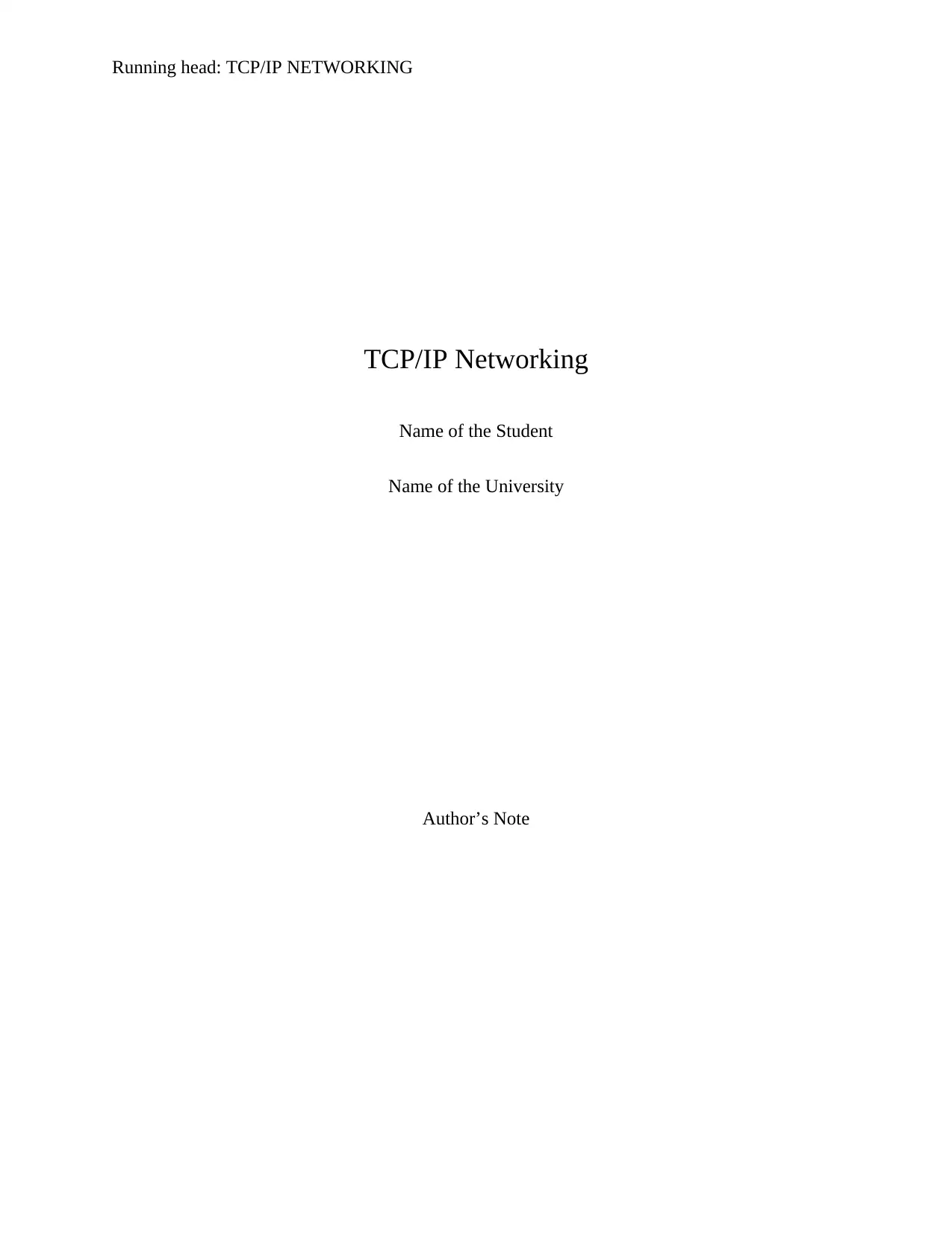
Running head: TCP/IP NETWORKING
TCP/IP Networking
Name of the Student
Name of the University
Author’s Note
TCP/IP Networking
Name of the Student
Name of the University
Author’s Note
Paraphrase This Document
Need a fresh take? Get an instant paraphrase of this document with our AI Paraphraser
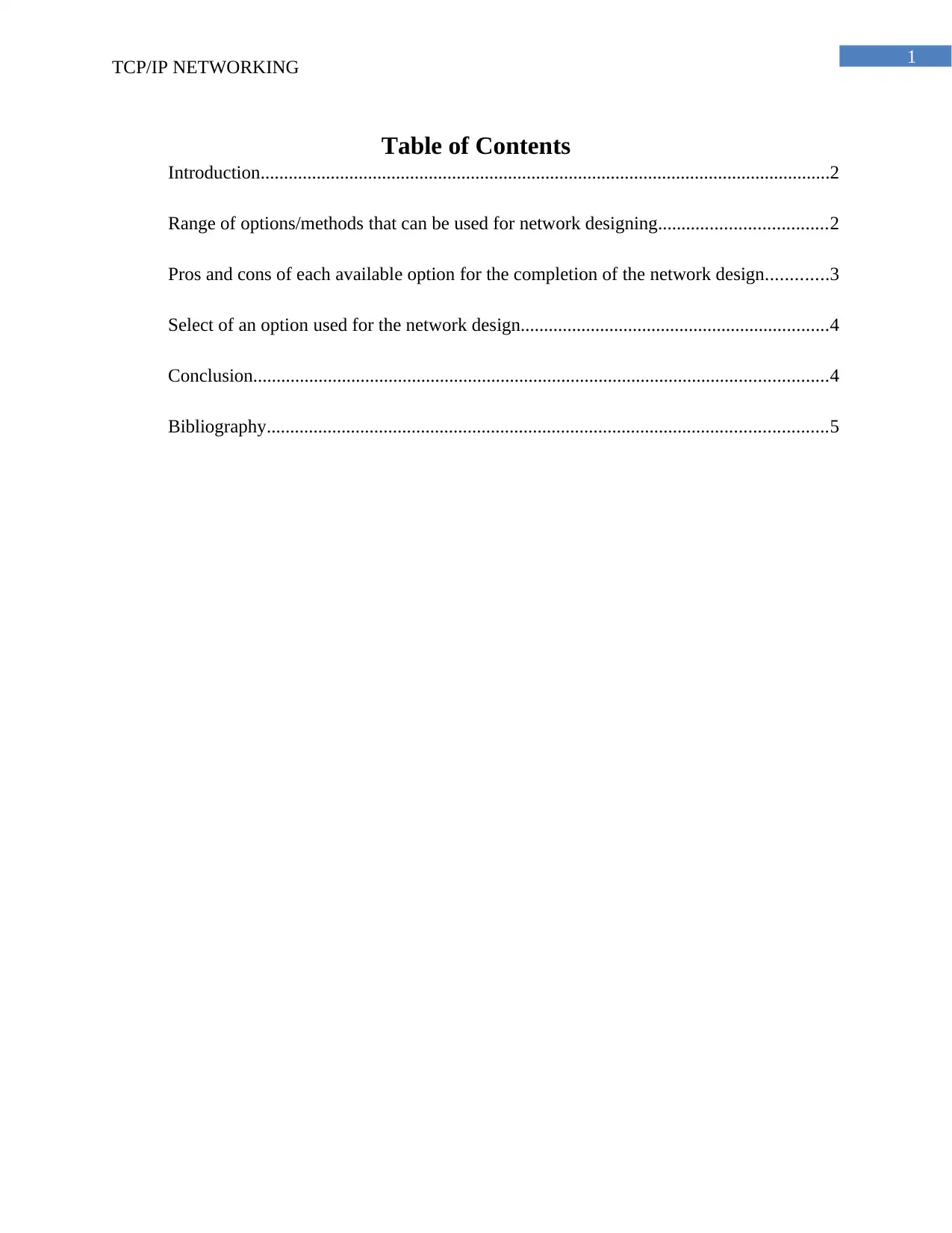
1
TCP/IP NETWORKING
Table of Contents
Introduction..........................................................................................................................2
Range of options/methods that can be used for network designing....................................2
Pros and cons of each available option for the completion of the network design.............3
Select of an option used for the network design..................................................................4
Conclusion...........................................................................................................................4
Bibliography........................................................................................................................5
TCP/IP NETWORKING
Table of Contents
Introduction..........................................................................................................................2
Range of options/methods that can be used for network designing....................................2
Pros and cons of each available option for the completion of the network design.............3
Select of an option used for the network design..................................................................4
Conclusion...........................................................................................................................4
Bibliography........................................................................................................................5
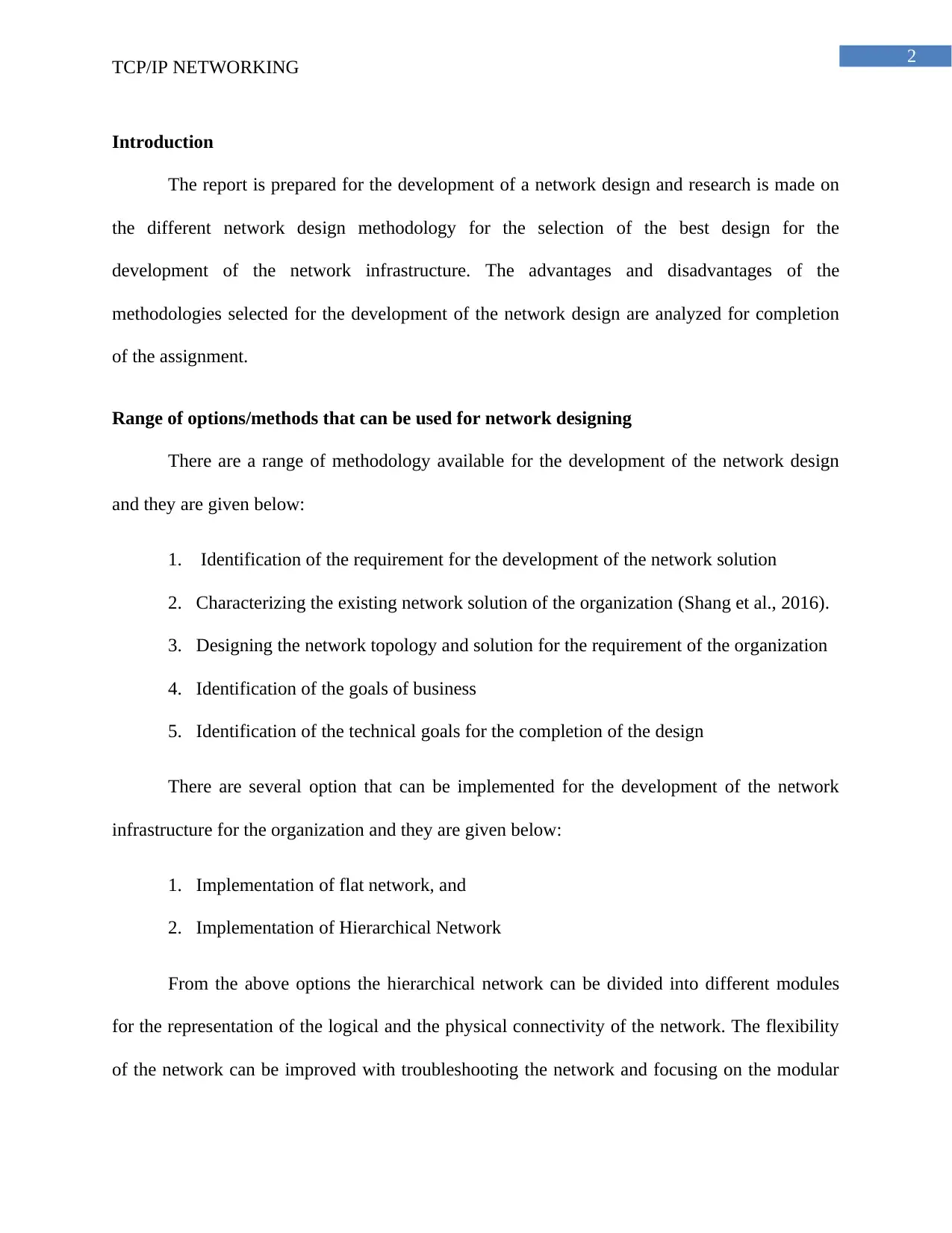
2
TCP/IP NETWORKING
Introduction
The report is prepared for the development of a network design and research is made on
the different network design methodology for the selection of the best design for the
development of the network infrastructure. The advantages and disadvantages of the
methodologies selected for the development of the network design are analyzed for completion
of the assignment.
Range of options/methods that can be used for network designing
There are a range of methodology available for the development of the network design
and they are given below:
1. Identification of the requirement for the development of the network solution
2. Characterizing the existing network solution of the organization (Shang et al., 2016).
3. Designing the network topology and solution for the requirement of the organization
4. Identification of the goals of business
5. Identification of the technical goals for the completion of the design
There are several option that can be implemented for the development of the network
infrastructure for the organization and they are given below:
1. Implementation of flat network, and
2. Implementation of Hierarchical Network
From the above options the hierarchical network can be divided into different modules
for the representation of the logical and the physical connectivity of the network. The flexibility
of the network can be improved with troubleshooting the network and focusing on the modular
TCP/IP NETWORKING
Introduction
The report is prepared for the development of a network design and research is made on
the different network design methodology for the selection of the best design for the
development of the network infrastructure. The advantages and disadvantages of the
methodologies selected for the development of the network design are analyzed for completion
of the assignment.
Range of options/methods that can be used for network designing
There are a range of methodology available for the development of the network design
and they are given below:
1. Identification of the requirement for the development of the network solution
2. Characterizing the existing network solution of the organization (Shang et al., 2016).
3. Designing the network topology and solution for the requirement of the organization
4. Identification of the goals of business
5. Identification of the technical goals for the completion of the design
There are several option that can be implemented for the development of the network
infrastructure for the organization and they are given below:
1. Implementation of flat network, and
2. Implementation of Hierarchical Network
From the above options the hierarchical network can be divided into different modules
for the representation of the logical and the physical connectivity of the network. The flexibility
of the network can be improved with troubleshooting the network and focusing on the modular
⊘ This is a preview!⊘
Do you want full access?
Subscribe today to unlock all pages.

Trusted by 1+ million students worldwide
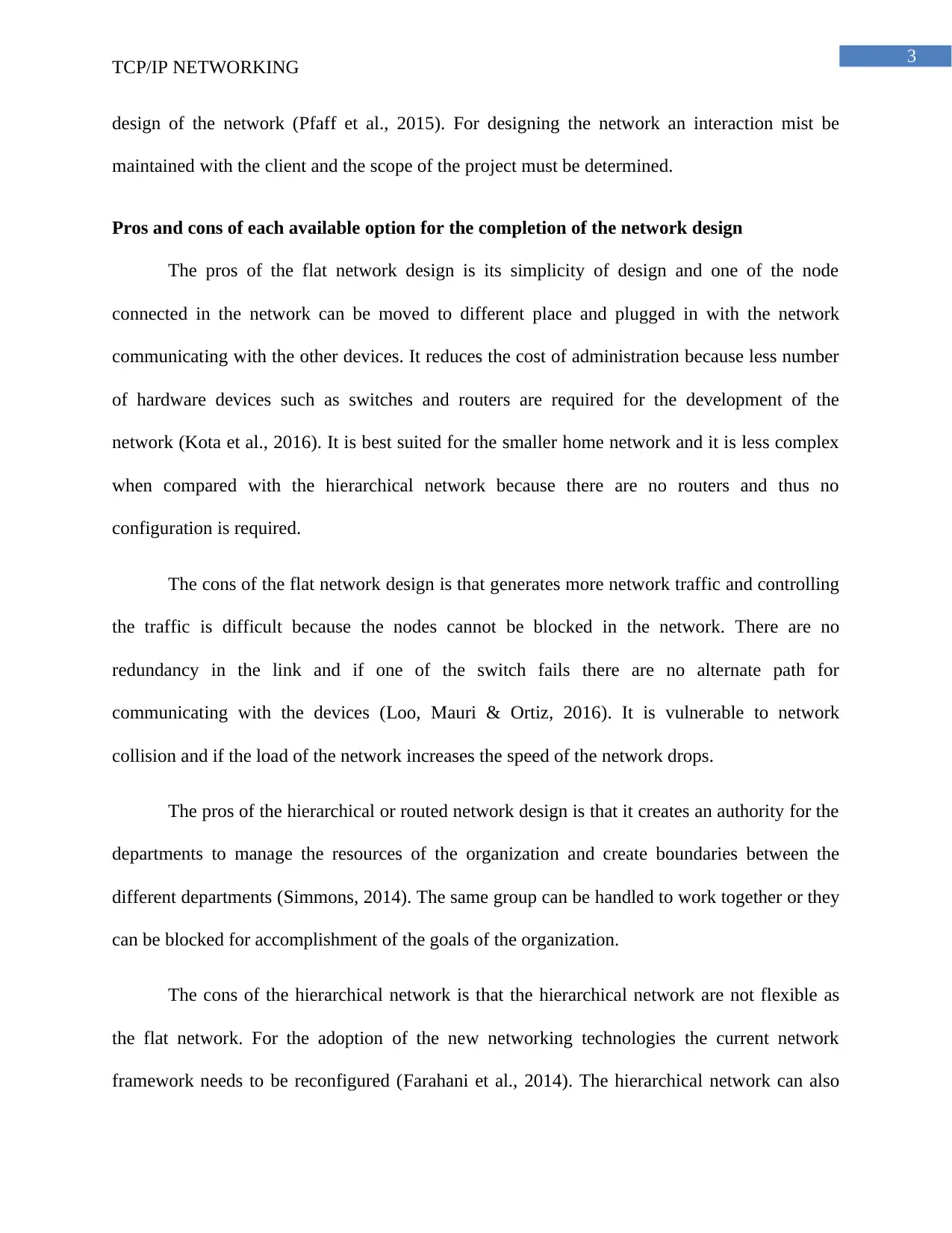
3
TCP/IP NETWORKING
design of the network (Pfaff et al., 2015). For designing the network an interaction mist be
maintained with the client and the scope of the project must be determined.
Pros and cons of each available option for the completion of the network design
The pros of the flat network design is its simplicity of design and one of the node
connected in the network can be moved to different place and plugged in with the network
communicating with the other devices. It reduces the cost of administration because less number
of hardware devices such as switches and routers are required for the development of the
network (Kota et al., 2016). It is best suited for the smaller home network and it is less complex
when compared with the hierarchical network because there are no routers and thus no
configuration is required.
The cons of the flat network design is that generates more network traffic and controlling
the traffic is difficult because the nodes cannot be blocked in the network. There are no
redundancy in the link and if one of the switch fails there are no alternate path for
communicating with the devices (Loo, Mauri & Ortiz, 2016). It is vulnerable to network
collision and if the load of the network increases the speed of the network drops.
The pros of the hierarchical or routed network design is that it creates an authority for the
departments to manage the resources of the organization and create boundaries between the
different departments (Simmons, 2014). The same group can be handled to work together or they
can be blocked for accomplishment of the goals of the organization.
The cons of the hierarchical network is that the hierarchical network are not flexible as
the flat network. For the adoption of the new networking technologies the current network
framework needs to be reconfigured (Farahani et al., 2014). The hierarchical network can also
TCP/IP NETWORKING
design of the network (Pfaff et al., 2015). For designing the network an interaction mist be
maintained with the client and the scope of the project must be determined.
Pros and cons of each available option for the completion of the network design
The pros of the flat network design is its simplicity of design and one of the node
connected in the network can be moved to different place and plugged in with the network
communicating with the other devices. It reduces the cost of administration because less number
of hardware devices such as switches and routers are required for the development of the
network (Kota et al., 2016). It is best suited for the smaller home network and it is less complex
when compared with the hierarchical network because there are no routers and thus no
configuration is required.
The cons of the flat network design is that generates more network traffic and controlling
the traffic is difficult because the nodes cannot be blocked in the network. There are no
redundancy in the link and if one of the switch fails there are no alternate path for
communicating with the devices (Loo, Mauri & Ortiz, 2016). It is vulnerable to network
collision and if the load of the network increases the speed of the network drops.
The pros of the hierarchical or routed network design is that it creates an authority for the
departments to manage the resources of the organization and create boundaries between the
different departments (Simmons, 2014). The same group can be handled to work together or they
can be blocked for accomplishment of the goals of the organization.
The cons of the hierarchical network is that the hierarchical network are not flexible as
the flat network. For the adoption of the new networking technologies the current network
framework needs to be reconfigured (Farahani et al., 2014). The hierarchical network can also
Paraphrase This Document
Need a fresh take? Get an instant paraphrase of this document with our AI Paraphraser
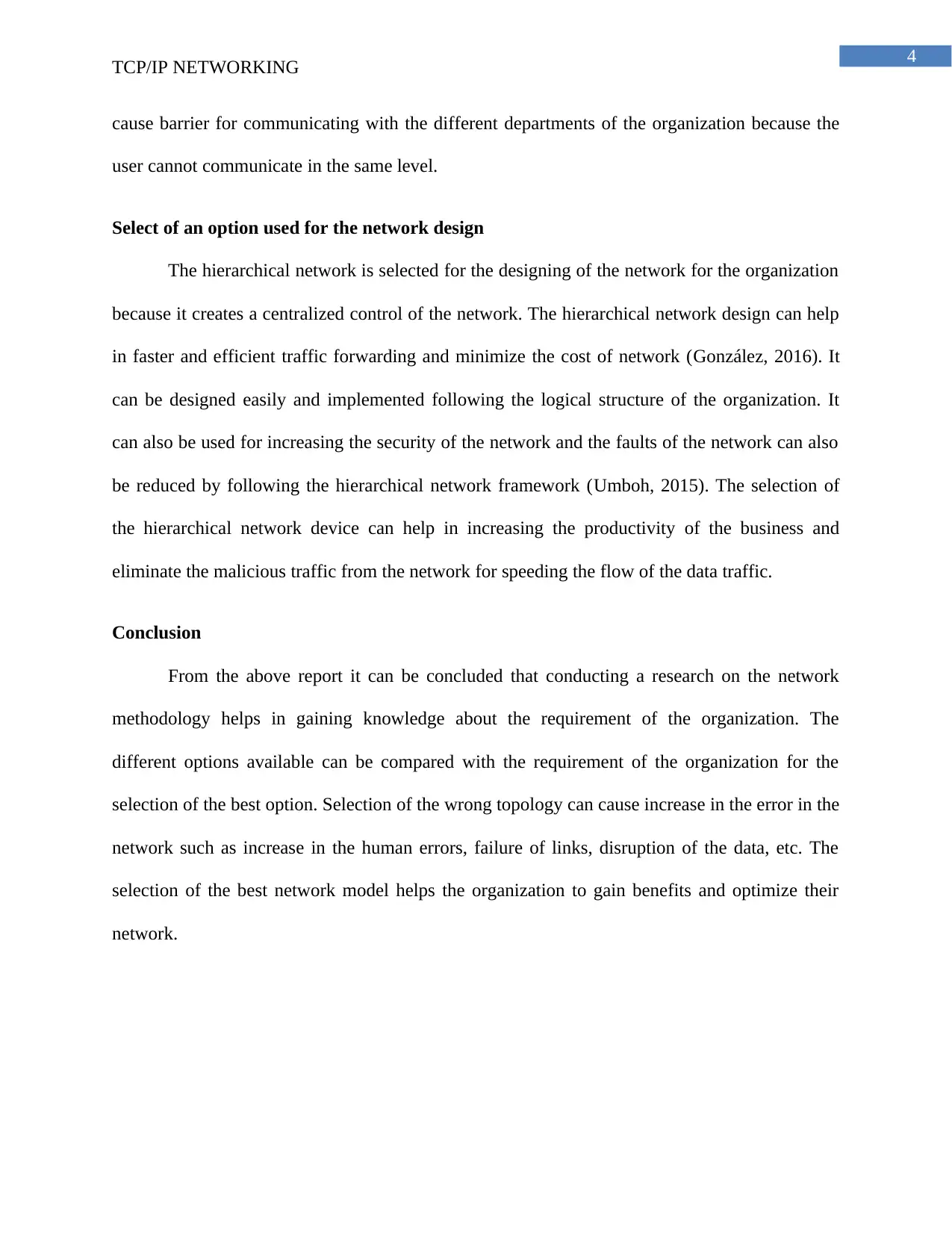
4
TCP/IP NETWORKING
cause barrier for communicating with the different departments of the organization because the
user cannot communicate in the same level.
Select of an option used for the network design
The hierarchical network is selected for the designing of the network for the organization
because it creates a centralized control of the network. The hierarchical network design can help
in faster and efficient traffic forwarding and minimize the cost of network (González, 2016). It
can be designed easily and implemented following the logical structure of the organization. It
can also be used for increasing the security of the network and the faults of the network can also
be reduced by following the hierarchical network framework (Umboh, 2015). The selection of
the hierarchical network device can help in increasing the productivity of the business and
eliminate the malicious traffic from the network for speeding the flow of the data traffic.
Conclusion
From the above report it can be concluded that conducting a research on the network
methodology helps in gaining knowledge about the requirement of the organization. The
different options available can be compared with the requirement of the organization for the
selection of the best option. Selection of the wrong topology can cause increase in the error in the
network such as increase in the human errors, failure of links, disruption of the data, etc. The
selection of the best network model helps the organization to gain benefits and optimize their
network.
TCP/IP NETWORKING
cause barrier for communicating with the different departments of the organization because the
user cannot communicate in the same level.
Select of an option used for the network design
The hierarchical network is selected for the designing of the network for the organization
because it creates a centralized control of the network. The hierarchical network design can help
in faster and efficient traffic forwarding and minimize the cost of network (González, 2016). It
can be designed easily and implemented following the logical structure of the organization. It
can also be used for increasing the security of the network and the faults of the network can also
be reduced by following the hierarchical network framework (Umboh, 2015). The selection of
the hierarchical network device can help in increasing the productivity of the business and
eliminate the malicious traffic from the network for speeding the flow of the data traffic.
Conclusion
From the above report it can be concluded that conducting a research on the network
methodology helps in gaining knowledge about the requirement of the organization. The
different options available can be compared with the requirement of the organization for the
selection of the best option. Selection of the wrong topology can cause increase in the error in the
network such as increase in the human errors, failure of links, disruption of the data, etc. The
selection of the best network model helps the organization to gain benefits and optimize their
network.
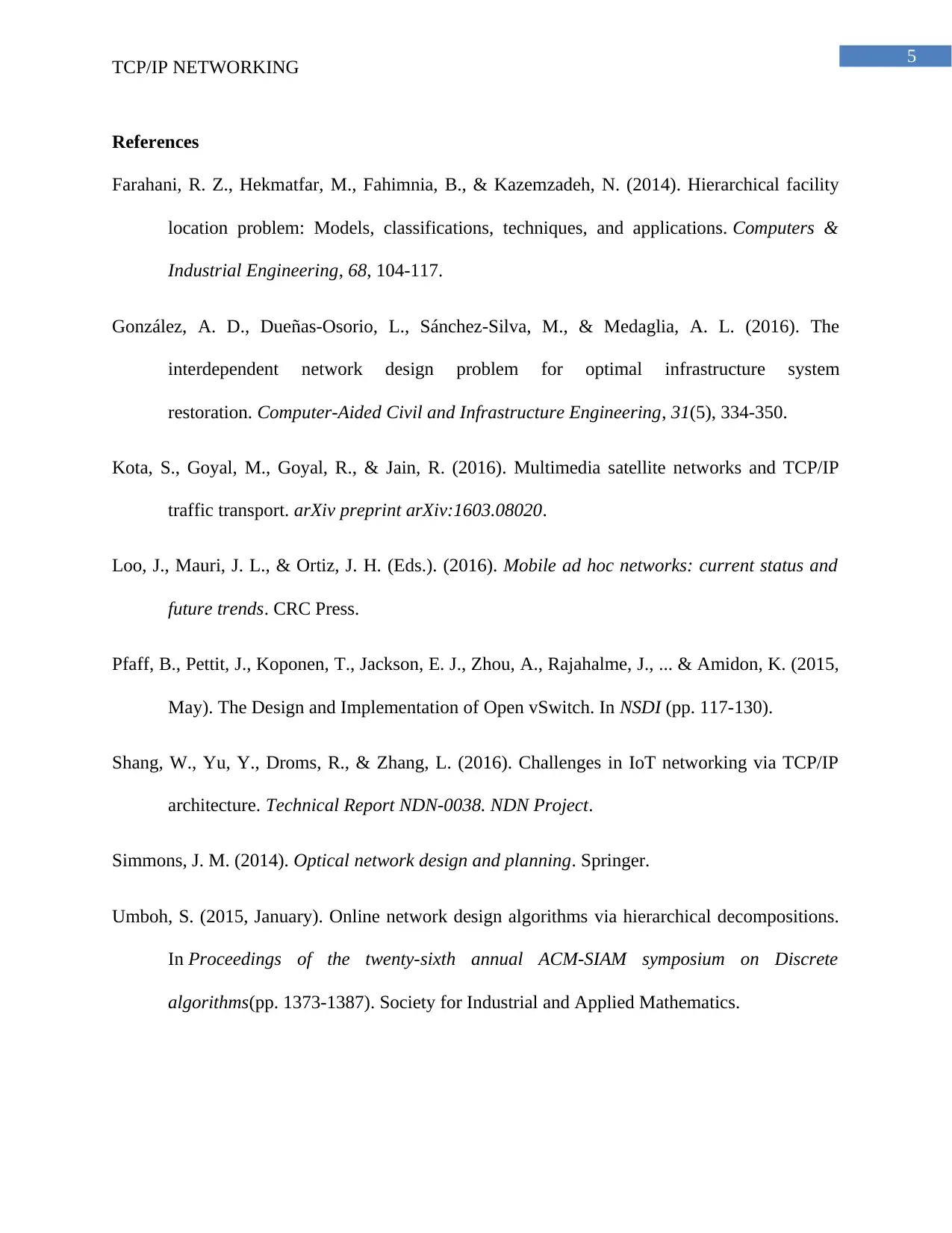
5
TCP/IP NETWORKING
References
Farahani, R. Z., Hekmatfar, M., Fahimnia, B., & Kazemzadeh, N. (2014). Hierarchical facility
location problem: Models, classifications, techniques, and applications. Computers &
Industrial Engineering, 68, 104-117.
González, A. D., Dueñas‐Osorio, L., Sánchez‐Silva, M., & Medaglia, A. L. (2016). The
interdependent network design problem for optimal infrastructure system
restoration. Computer‐Aided Civil and Infrastructure Engineering, 31(5), 334-350.
Kota, S., Goyal, M., Goyal, R., & Jain, R. (2016). Multimedia satellite networks and TCP/IP
traffic transport. arXiv preprint arXiv:1603.08020.
Loo, J., Mauri, J. L., & Ortiz, J. H. (Eds.). (2016). Mobile ad hoc networks: current status and
future trends. CRC Press.
Pfaff, B., Pettit, J., Koponen, T., Jackson, E. J., Zhou, A., Rajahalme, J., ... & Amidon, K. (2015,
May). The Design and Implementation of Open vSwitch. In NSDI (pp. 117-130).
Shang, W., Yu, Y., Droms, R., & Zhang, L. (2016). Challenges in IoT networking via TCP/IP
architecture. Technical Report NDN-0038. NDN Project.
Simmons, J. M. (2014). Optical network design and planning. Springer.
Umboh, S. (2015, January). Online network design algorithms via hierarchical decompositions.
In Proceedings of the twenty-sixth annual ACM-SIAM symposium on Discrete
algorithms(pp. 1373-1387). Society for Industrial and Applied Mathematics.
TCP/IP NETWORKING
References
Farahani, R. Z., Hekmatfar, M., Fahimnia, B., & Kazemzadeh, N. (2014). Hierarchical facility
location problem: Models, classifications, techniques, and applications. Computers &
Industrial Engineering, 68, 104-117.
González, A. D., Dueñas‐Osorio, L., Sánchez‐Silva, M., & Medaglia, A. L. (2016). The
interdependent network design problem for optimal infrastructure system
restoration. Computer‐Aided Civil and Infrastructure Engineering, 31(5), 334-350.
Kota, S., Goyal, M., Goyal, R., & Jain, R. (2016). Multimedia satellite networks and TCP/IP
traffic transport. arXiv preprint arXiv:1603.08020.
Loo, J., Mauri, J. L., & Ortiz, J. H. (Eds.). (2016). Mobile ad hoc networks: current status and
future trends. CRC Press.
Pfaff, B., Pettit, J., Koponen, T., Jackson, E. J., Zhou, A., Rajahalme, J., ... & Amidon, K. (2015,
May). The Design and Implementation of Open vSwitch. In NSDI (pp. 117-130).
Shang, W., Yu, Y., Droms, R., & Zhang, L. (2016). Challenges in IoT networking via TCP/IP
architecture. Technical Report NDN-0038. NDN Project.
Simmons, J. M. (2014). Optical network design and planning. Springer.
Umboh, S. (2015, January). Online network design algorithms via hierarchical decompositions.
In Proceedings of the twenty-sixth annual ACM-SIAM symposium on Discrete
algorithms(pp. 1373-1387). Society for Industrial and Applied Mathematics.
⊘ This is a preview!⊘
Do you want full access?
Subscribe today to unlock all pages.

Trusted by 1+ million students worldwide
1 out of 6
Related Documents
Your All-in-One AI-Powered Toolkit for Academic Success.
+13062052269
info@desklib.com
Available 24*7 on WhatsApp / Email
![[object Object]](/_next/static/media/star-bottom.7253800d.svg)
Unlock your academic potential
Copyright © 2020–2025 A2Z Services. All Rights Reserved. Developed and managed by ZUCOL.




![Network Design Methods for TEMAOS - Assessment 3 - [University Name]](/_next/image/?url=https%3A%2F%2Fdesklib.com%2Fmedia%2Fimages%2Fcs%2F077596fabd9840ffa52d8bc0a9d40c24.jpg&w=256&q=75)
